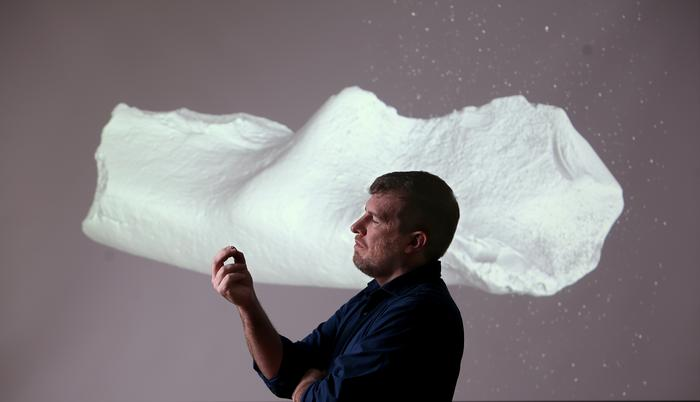Monotremes, now known only from the platypus and a handful of echidna species, were once a much more successful order, with three new species now identified from a single geologic formation. Yet while their diversity has dwindled, the egg-laying mammals appear to be onto a good thing. Indeed, their body design has changed so little in a hundred million years that one of the finds is being referred to as an “echidnapus”.
Australia is not the place to live and die if you want the world to remember you millions of years later, being particularly poor in sites suited for creating and revealing fossils. However, the Lightning Ridge opal fields ensure that if your bones are preserved, there is a fair chance they will look absolutely fabulous.
Three new species of monotremes have now been identified from 102-96.6 million-year-old fossil deposits at Lightning Ridge, bringing the number of species known from that place and time to six. In some other contexts, six species might be quite modest – but these account for a third of the known genera of monotremes in the 130-million-year history of the order. The site, therefore, is a relative treasure-trove the like of which we have found nowhere else.
An added point of interest, Professor Kris Helgen of the Australian Museum told IFLScience, is that no non-monotreme mammals have been found at Lightning Ridge, in complete contrast to the ratio we see today.
“Today, Australia is known as a land of marsupials, but discovering these new fossils is the first indication that Australia was previously home to a diversity of monotremes. It’s like discovering a whole new civilization,” said first author Professor Tim Flannery of the Australian Museum in a statement.
The highlight of the three discoveries goes by the catchy name of Opalios splendens and has a number of features familiar from surviving monotremes.
“Opalios splendens sits on a place in the evolutionary tree prior to the evolution of the common ancestor of the monotremes we have today. Its overall anatomy is probably quite like the platypus, but with features of the jaw and snout a bit more like an echidna – you might call it an ‘echidnapus’,” said Helgen.
Appropriately named given publication this month, the second species is Dharragarra aurora, the oldest fossil identified as a type of platypus.
Parvopalus clytiei is the smallest of the mammalian fossils at Lightning Ridge, and is known from such limited pieces little can be said about it.

Professor Kris Helgen holding up a tiny fossil jaw fragment from which a species has been described, with a giant image of the fossil on the screen behind him.
Image Credit: James Alcock / Australian Museum
Both D. aurora and P. clytiei were on the “toothy to toothless path” monotremes have trodden, having lost at least one of the five molars the first monotreme, Teinolophos trulseri, possessed.
The sparse availability of fossil monotremes leaves scientists with a great many questions about why their evolution followed such a different path from other mammals. Back when monotremes and theriiform mammals split, both had to make their way in the exceptionally difficult world dominated by dinosaurs. Many ecological niches were closed to both, particularly those that involved getting large enough to attract unwanted attention.
However, when the death of the non-avian dinosaurs, and a great many other species as well, opened a world of opportunities, Theriiformes jumped at it – including literally, by evolving into dozens of kangaroo species. Meanwhile, monotremes hung on, but never seemed to have diversified much.
Helgen told IFLScience that five of the six monotreme species found at Lightning Ridge are quite different from each other, based on size and body plan. Given the constraints at the time, that suggests a capacity to diversify. Yet when the world changed 65 million years ago, monotremes didn’t, with modern echidnas and platypuses sticking fairly closely to the structures on display in this deposit. Meanwhile, as he noted, theriiforme mammals; “Vary from bats to whales to kangaroos.”
“It seems like a good working hypothesis,” Helgen told IFLScience, that something limits monotreme flexibility, but what that is we don’t know.
Equally unknown is why monotremes were able to establish a significant presence in Australia, but not elsewhere. Although they probably never made it to the northern continents, two species of monotreme fossils have been found in South America, yet apparently did not thrive. It’s likely others were in Antarctica, at the time the bridge between the two continents, but logistical difficulties mean we know nothing about them, or how they competed with other mammals.
Lightning Ridge is now very hot and dry, but at the time the monotremes flourished was heavily forested and at a latitude similar to Anchorage. It probably still has much to reveal. We only have a single bone or tooth from each of four of the species, suggesting there are probably many more inhabitants we are yet to find.
Every monotreme fossil from Lightning Ridge has been opalized by geologists’ standards. Indeed, these fossils have either been spotted by alert opal-hunters noticing something animal-related, or paleontologists going through miners’ waste. However, those described here lack the beautiful mix of colors associated with opals, unlike a dinosaur fossil found in 2013 at the same site.
“Opal fossils are rare, but opalized monotreme fossils are infinitely more rare, as there’s one monotreme fragment to a million other pieces. We don’t know when, or exactly where, they’ll turn up,” said Elizabeth Smith, who found the newly described fossils along with her daughter.
The three new species are described and named in Alcheringa: An Australian Journal of Palaeontology, along with descriptions of an additional bone from a previously identified species.
Source Link: "Echidnapus" Among Three New Species That Reveal A Lost Land Of The Monotremes